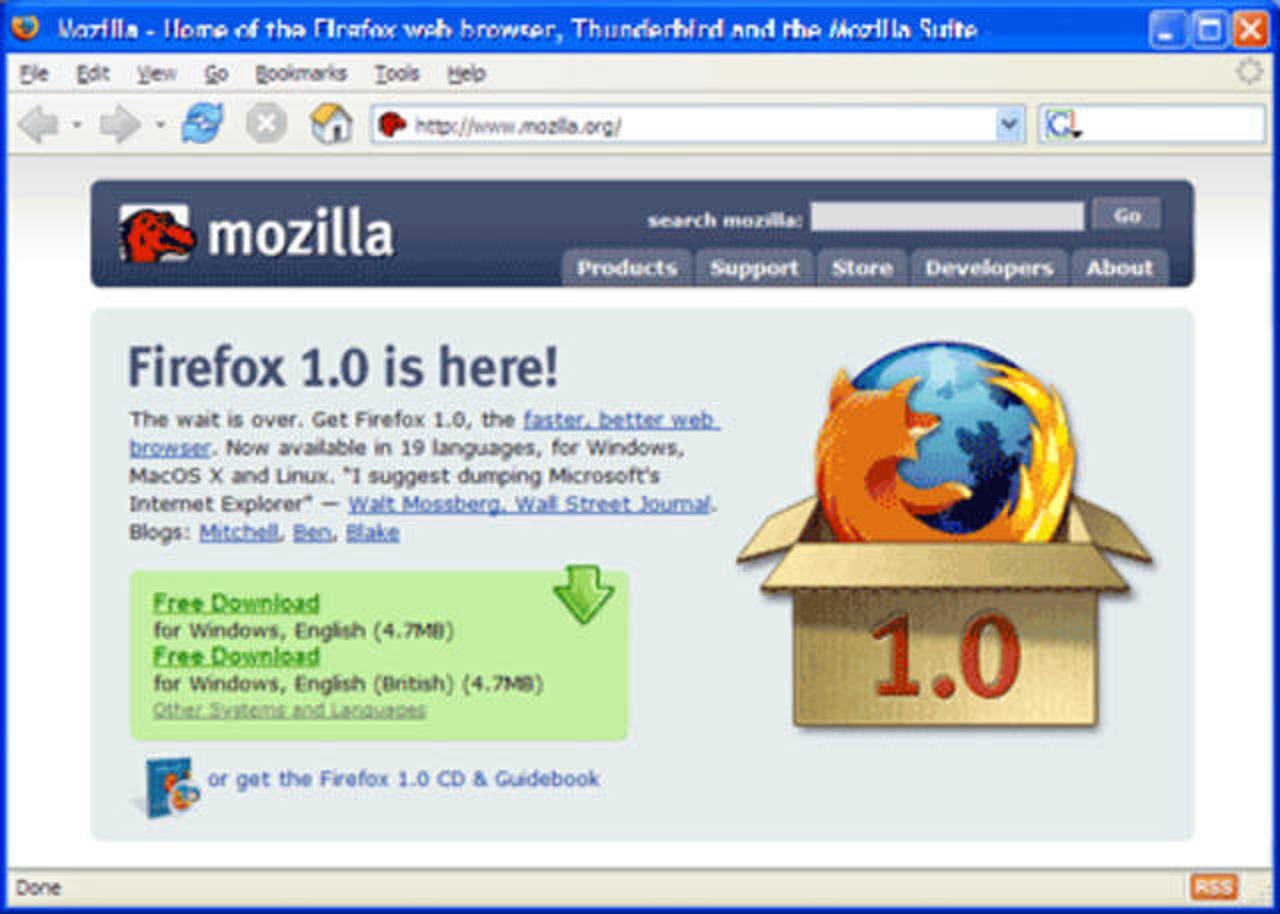How Microsoft lost its monopoly in web browsers

1994: In the beginning, there was Netscape
There were other browsers before it, but Netscape Navigator was the first to capture significant market share. The company, founded by Marc Andreessen, went public in 1995 in an IPO that arguably sparked a revolution and then a bubble in Internet stocks.
Andreessen ambitiously boasted that Netscape would "reduce Windows to a set of poorly debugged device drivers." Microsoft fought back aggressively, leading eventually to an antitrust case.
Netscape CEO James Barksdale testified about one meeting with Microsoft: "I had never been in a meeting in my 33-year business career in which a competitor had so blatantly implied that we should either stop competing with it or the competitor would kill us."
Netscape sold to AOL in 1999, but the browser's source code became the basis of the Mozilla project.
1995: Windows 95 adds the Internet Connection Wizard
When Microsoft released the first Internet Explorer, most people were using dial-up modems to connect to the Web. And before Windows 95, you had to buy a separate program (like the venerable Trumpet Winsock) to add the required TCP/IP networking components.
The Internet Connection Wizard seems clunky a quarter-century later, but it was revolutionary at the time.
1995: Internet Explorer debuts in OEM versions of Windows 95
Every PC user remembers the public launch of Windows 95 in August 1995, but you might not recall that Internet Explorer wasn't part of those retail copies. Instead, it was released in the Plus Pack at an extra cost.
A few months later, Microsoft released Windows 95 to OEMs, who shipped new PCs that included the new browser as well as the new operating system.
The original release was based on a modified version of the Mosaic code licensed from Spyglass. A year later, with Windows 95 OEM Service Release 2, Internet Explorer was already up to version 3.0.
1997: IE4 ties the Active Desktop tightly to Windows
In the late 1990s, Microsoft still had cross-platform ambitions for its browser, and Internet Explorer 4 was released for Windows 95, Windows NT, Mac OS (OS X was still years away), and even UNIX.
This was the first version of the browser to include the Trident rendering engine. And when version 4.01 shipped with Windows 98, it was tied tightly to the desktop with a series of Active Desktop widgets that were intended to put Web-based content directly on the desktop.
The feature was poorly received and didn't survive into the XP era.
2001: IE6 arrives with Windows XP, and stays for five years
Between 1995 and 2001, Microsoft released six major versions of Internet Explorer. Version 6 was included with the 2001 release of Windows XP and later in Windows Server 2003.
By 2001, Microsoft had given up on its cross-platform dreams. IE6 was backported to Windows NT, Windows 2000, Windows 98, and Windows Me, but was not released for non-Microsoft operating systems.
After this release, Microsoft effectively gave up on the browser for the next five years, offering security fixes but no new features. As the default browser for Windows, it maintained its dominance, especially among corporate customers.
2001: To settle antitrust charges, Microsoft backs away from the Web
Why did Microsoft give up on Internet Explorer development for five years after releasing IE6? Look no further than its loss in the landmark antitrust case, United States v. Microsoft. The case hinged in no small measure on Microsoft's predatory behavior in crushing Netscape.
As part of the settlement in that case, which was reached just before Windows XP shipped, Microsoft agreed not to interfere with the ability of other browser makers to cut deals with OEMs. It was a Pyrrhic victory for Netscape, however, which had already been swallowed up by AOL by that time.
1996-2011: ActiveX unleashes a flood of security issues
Microsoft introduced its ActiveX technology in 1996. In a January 2001 post for TechRepublic, I wrote this:
"I've never been able to shake a nagging mistrust of the fundamental principle behind ActiveX. After all, ActiveX controls are nothing more than software, potentially powerful binary programs that can be delivered over a network, installed automatically, and controlled from nearly anywhere. Shouldn't you keep a close eye on any software that appears on your PC?"
As it turns out, that mistrust was well-placed. ActiveX became a vector for crapware and spyware. In the 1990s, security expert Richard M. Smith developed the third-party ActiveX control tool shown here. It took Microsoft many more years (until IE9, in fact) to finally introduce options to stop unwanted ActiveX controls from executing.
One of the key selling points of Microsoft Edge in Windows 10 was that it didn't include ActiveX support.

2004: Mozilla Firefox offers a major challenge to IE's dominance
When the Firefox browser was released to the public in 2004, it seemed quixotic. Most PC users weren't accustomed to open source, and the idea that this little company could take on mighty Microsoft was hard to believe.
But the browser (based on the original Netscape code) was solid, and it offered new features like tabbed browsing and support for extensions. Meanwhile, IE6 was static and unchanging and was beset by one security problem after another.
The tech press flocked to the new kid on the block, and within a few years Firefox was making a serious run at its older, slower rival. At its peak, some measurements of web usage showed Firefox with a share as high as 40%.
2006: IE7 adds tabbed browsing, but it's too little, very late
The challenge from Firefox awakened the slumbering giant in Redmond, which unveiled the first new version of Internet Explorer in five years. The biggest change was the addition of tabbed browsing, which had been a major reason for people switching to Firefox.
IE7 also included a host of security changes and some improvements aimed at enterprises, but it did little to win back consumers and small businesses. The fact that it shipped as the default browser in the ill-fated Windows Vista didn't help.
2008: With Chrome 1.0, Google begins a long march to browser hegemony
In 2008, rumors that Google was getting ready to release its own Web browser turned out to be true. The initial release of Google Chrome was for Windows only, and the name was a typical Google-esque joke, because the whole point of the browser is that it didn't include the typical "chrome" associated with other browsers.
To introduce its new baby, Google released a 64-page comic book explaining how the browser worked.
Versions for Linux, OS X, and mobile platforms followed later. PC and Mac users who were tired of their old, slow browsers were ready converts, and Chrome began a long, steady march to the undisputed market dominance it enjoys today.
2010: Microsoft begs users to dump "out of date" IE6
By 2010, the troubles with Internet Explorer 6 were dire for Microsoft. It was still uncomfortably popular, but it was also woefully insecure and a poor fit for modern Web standards. Developers were openly dropping support for Internet Explorer and customers were flocking to the alternatives from Mozilla and Google.
After the release of Internet Explorer 8, which was the default browser in Windows 7, Microsoft took the unusual step of creating its own ads. The goal was to convince the enormous base of Windows XP holdouts that it was time to dump that old browser. "You wouldn't drink 9-year-old milk. So why use a 9-year-old browser?"
Of course, the target market for those ads consisted of organizations happily running a nine-year-old operating system that would continue to be supported for another five years, so ¯\_(ツ)_/¯.
2010-2013: EU antitrust regulators force Microsoft to offer a browser choice
The 2001 Microsoft consent decree expired in 2011. That was just in time for the company to lose another antitrust case, this time in the European Union. To settle charges of anticompetitive behavior, the company agreed to ship all new copies of Windows sold in the EU with a "browser ballot" like the one shown here.
The idea was that anyone setting up a new Windows PC could take their choice of five browsers from a screen that presented those choices in a random order.
Unfortunately, the company screwed up and stopped offering the browser ballot over an 18-month period. That technical error cost Microsoft a fine of more than $700 million.
2012: With Windows 8, Microsoft splits Internet Explorer in two
Windows 8 was going to revolutionize the PC, making it possible for laptops to turn into tablets with a revolutionary tile-based user interface.
As part of that grand vision, Internet Explorer was included in two separate versions on Windows 8. The conventional desktop version was much like its predecessors, but the "modern" IE was full-screen only, with the address bar on the bottom and an odd approach to handling tabs.
Modern IE was about as successful as Windows 8, which is the polite way of saying it was abandoned less than three years later.
2013: Internet Explorer 11, the final version, lives on in Windows 10
No one knew it at the time of its release, but Internet Explorer 11 was the last version ever. It's the only version still supported on Windows, and although it's included with Windows 10 it's no longer the default.
Internet Explorer hangs on stubbornly largely because of corporate customers who long ago designed line-of-business apps that won't work on modern browsers. Microsoft has tried to pry users off its old platform with "Internet Explorer mode," but the usage of IE 11 remains stubbornly high.
Microsoft still ships security fixes for IE 11, but development of new features stopped in 2016.
2015: Microsoft Edge replaces Internet Explorer on Windows 10
If Windows 10 was a repudiation of Windows 8 (even skipping a whole version number to add some extra distance), Microsoft Edge is a repudiation of Internet Explorer. In Windows 10, Edge is the default browser, and Internet Explorer is an option.
To build the EdgeHTML rendering engine that is at the core of the new browser, Microsoft's engineers started with the old Trident engine and ripped away code that was there for backward compatibility. The pieces that didn't survive the transition included ActiveX and a confusing array of document modes.
Alas, Edge was literally unfinished when it shipped with the first version of Windows 10. It took nearly a year for extensions to appear, for example. To Microsoft's chagrin, most people firing up a new Windows 10 PC used Edge only once, to download their preferred browser.
2019: Microsoft reboots Edge, using open-source Chromium engine
The goal of the original Microsoft Edge, Microsoft said, was to build a modern browser that focused on Web standards rather than backward compatibility. By some measures, it did a very good job with that task, but that compatibility came at an enormous engineering cost.
Even if only a few percent of sites had trouble rendering properly in Edge, that was enough to send users running to the comfort of Google Chrome.
So, at the end of 2018, Microsoft announced it was abandoning EdgeHTML and would rebuild its default browser using the open-source Chromium engine that's also at the heart of Chrome. As of August 2019, the new browser is in wide preview release in three channels, on all supported versions of Windows, on MacOS, and on iOS and Android.
One of the signature features of the new Edge is Tracking Protection, as shown here. The first version of Edge to appear as part of Windows 10 won't arrive until 2020.